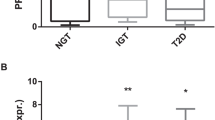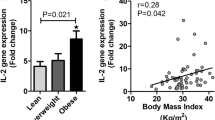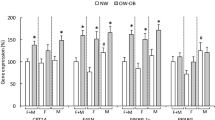Abstract
Background:
Glucose-dependent insulinotropic peptide (GIP) provides a novel link between the immune system and the gut, although results from different experimental and observational studies are contradictory, ranging from anti-inflammatory, through neutral to pro-inflammatory action of GIP. Thus, the aim of this study was to analyze inflammatory pathways on the level of gene expression and circulating inflammatory markers in relation to plasma GIP level.
Subjects/Methods:
The study included 128 obese adults. Two groups of obese subjects were created according to fasting GIP levels, with cutoff point at the 66th percentile and compared in respect with molecular and circulating markers of inflammation. GIP, interleukin (IL)-6 and adipokines: leptin, adiponectin, visfatin were measured by enzyme-linked immunosorbent assay. Inflammatory markers: monocyte chemoattractant protein-1 (MCP-1), sE-Selectin, sVCAM-1, sPECAM-1 were studied at fasting and after nutrient challenges. Gene expression in blood cells was determined by human gene microarray.
Results:
Obese patients with high GIP levels had elevated fasting glucose (Q2 (Q1–Q3): 5.6 (5.0–6.0) vs 5.0 (4.8–5.4), P<0.001), homeostasis model assessment of insulin resistance (Q2 (Q1–Q3): 3.68 (2.72–5.42) vs 2.70 (2.13–4.33), P=0.021), thus increased markers of insulin resistance as well as elevated inflammatory markers Il-6 (Q2 (Q1–Q3): 1.34 (1.0–2.04) vs 1.12 (0.76–1.64), P=0.045), MCP-1 (Q2 (Q1–Q3): 363 (287–447) vs 323 (263–389), P=0.026). Leptin to adiponectin ratio was significantly associated with fasting plasma GIP levels (β (95% CI): 0.84 (0.10–1.59)) independently of glucose levels. sE-Selectin was found to be a factor influencing GIP response to oral glucose intake (β (95% CI): 0.47 (0.14–0.81)) and sVCAM was found to be a factor influencing GIP response to high-fat meal intake (β (95% CI): 0.19 (0.01–0.37)). We identified 32 genes of inflammatory pathways differentially expressed in subjects with a high plasma GIP level compared to low GIP. Most upregulated genes play a role in leukocyte chemotaxis and tissue infiltration.
Conclusions:
These findings support the hypothesis that increased GIP signaling has a role in chronic low-grade inflammation.
This is a preview of subscription content, access via your institution
Access options
Subscribe to this journal
Receive 12 print issues and online access
$259.00 per year
only $21.58 per issue
Buy this article
- Purchase on Springer Link
- Instant access to full article PDF
Prices may be subject to local taxes which are calculated during checkout


Similar content being viewed by others
References
Choe SS, Huh JY, Hwang IJ, Kim JI, Kim JB . Adipose tissue remodeling. Its role in energy metabolism and metabolic disorders. Front Endocrinol (Lausanne) 2016; 7: 30.
Cildir G, Akıncılar SC, Tergaonkar V . Chronic adipose tissue inflammation: all immune cells on the stage. Trends Mol Med 2013; 8: 487–500.
Mancuso P . The role of adipokines in chronic inflammation. Immunotargets Ther 2016; 5: 47–56.
Kang YE, Kim JM, Joung KH, Lee JH, You BR, Choi MJ et al. The roles of adipokines, proinflammatory cytokines, and adipose tissue macrophages in obesity-associated insulin resistance in modest obesity and early metabolic dysfunction. PLoS ONE 2016; 11: e0154003.
Blüher M . Adipose tissue inflammation: a cause or consequence of obesity-related insulin resistance? Clin Sci (Lond) 2016; 130: 1603–1614.
Gögebakan Ö, Osterhoff MA, Schüler R, Pivovarova O, Kruse M, Seltmann AC et al. GIP increases adipose tissue expression and blood levels of MCP-1 in humans and links high energy diets to inflammation: a randomised trial. Diabetologia 2015; 58: 1759–1768.
Ahlqvist E, Osmark P, Kuulasmaa T, Pilgaard K, Omar B, Brøns C et al. Link between GIP and osteopontin in adipose tissue and insulin resistance. Diabetes 2013; 62: 2088–2094.
Varol C, Zvibel I, Spektor L, Mantelmacher FD, Vugman M, Thurm T et al. Long-acting glucose-dependent insulinotropic polypeptide ameliorates obesity-induced adipose tissue inflammation. J Immunol 2014; 193: 4002–4009.
Timper K, Dalmas E, Dror E, Rütti S, Thienel C, Sauter NS et al. Glucose-dependent insulinotropic peptide stimulates glucagon-like peptide 1 production by pancreatic islets via interleukin 6, produced by α cells. Gastroenterology 2016; 151: 165–179.
Chen S, Okahara F, Osaki N, Shimotoyodome A . Increased GIP signaling induces adipose inflammation via a HIF-1α-dependent pathway and impairs insulin sensitivity in mice. Am J Physiol Endocrinol Metab 2015; 308: E414–E425.
Dupre J, Ross SA, Watson D, Brown JC . Stimulation of insulin secretion by gastric inhibitory polypeptide in man. J Clin Endocrinol Metab 1973; 37: 826–828.
Gniuli D, Calcagno A, Dalla Libera L, Calvani R, Leccesi L, Caristo ME et al. High-fat feeding stimulates endocrine, glucose-dependent insulinotropic polypeptide (GIP)-expressing cell hyperplasia in the duodenum of Wistar rats. Diabetologia 2010; 53: 2233–2240.
Christensen MB . Glucose-dependent insulinotropic polypeptide: effects on insulin and glucagon secretion in humans. Dan Med J 2016; 63: B5230.
Finan B, Müller TD, Clemmensen C, Perez-Tilve D, DiMarchi RD, Tschöp MH . Reappraisal of GIP pharmacology for metabolic diseases. Trends Mol Med 2016; 22: 359–376.
Trümper A, Trümper K, Trusheim H, Arnold R, Göke B, Hörsch D . Glucose-dependent insulinotropic polypeptide is a growth factor for beta (INS-1) cells by pleiotropic signaling. Mol Endocrinol 2001; 15: 1559–1570.
Meier JJ, Gallwitz B, Siepmann N, Holst JJ, Deacon CF, Schmidt WE et al. Gastric inhibitory polypeptide (GIP) dose-dependently stimulates glucagon secretion in healthy human subjects at euglycaemia. Diabetologia 2003; 46: 798–801.
Christensen M, Calanna S, Sparre-Ulrich AH, Kristensen PL, Rosenkilde MM, Faber J et al. Glucose-dependent insulinotropic polypeptide augments glucagon responses to hypoglycemia in type 1 diabetes. Diabetes 2015; 64: 72–78.
Ismail S, Dubois-Vedrenne I, Laval M, Tikhonova IG, D'Angelo R, Sanchez C et al. Internalization and desensitization of the human glucose-dependent-insulinotropic receptor is affected by N-terminal acetylation of the agonist. Mol Cell Endocrinol 2015; 414: 202–215.
Ismail S, Gherardi MJ, Froese A, Zanoun M, Gigoux V, Clerc P et al. Internalized receptor for glucose-dependent insulinotropic peptide stimulates adenylyl cyclase on early endosomes. Biochem Pharmacol 2016; 120: 33–45.
Kim SJ, Nian C, McIntosh CH . Activation of lipoprotein lipase by glucose-dependent insulinotropic polypeptide in adipocytes. A role for a protein kinase B, LKB1, and AMP-activated protein kinase cascade. J Biol Chem 2007; 282: 8557–8567.
McIntosh CH, Widenmaier S, Kim SJ . Glucose-dependent insulinotropic polypeptide signaling in pancreatic β-cells and adipocytes. J Diabetes Investig 2012; 3: 96–106.
Calanna S, Christensen M, Holst JJ, Laferrère B, Gluud LL, Vilsbøll T et al. Secretion of glucagon-like peptide-1 in patients with type 2 diabetes mellitus: systematic review and meta-analyses of clinical studies. Diabetologia 2013; 56: 965–972.
I. World Health Organization. II. International Diabetes Federation. Definition and diagnosis of diabetes mellitus and intermediate hyperglycemia: report of a WHO/IDF consultation. 4.Glucose tolerance test. ISBN 978 92 4 159493 6.
Holst JJ, Windeløv JA, Boer GA, Pedersen J, Svendsen B, Christensen M et al. Searching for the physiological role of glucose-dependent insulinotropic polypeptide. J Diabetes Investig 2016; 7: 8–12.
Suzuki Y, Nakamura N, Miyabe M, Nishikawa T, Miyajima S, Adachi K et al. Anti-inflammatory role of glucose-dependent insulinotropic polypeptide in periodontitis. J Diabetes Investig 2016; 7: 497–505.
Kahles F, Meyer C, Diebold S, Foldenauer AC, Stöhr R, Möllmann J et al. Glucose-dependent insulinotropic peptide secretion is induced by inflammatory stimuli in an interleukin-1-dependent manner in mice. Diabetes Obes Metab 2016; 18: 1147–1151.
Veilleux A, Mayeur S, Bérubé JC, Beaulieu JF, Tremblay E, Hould FS et al. Altered intestinal functions and increased local inflammation in insulin-resistant obese subjects: a gene-expression profile analysis. BMC Gastroenterol 2015; 15: 119.
Vilsbøll T, Krarup T, Sonne J, Madsbad S, Vølund A, Juul AG et al. Incretin secretion in relation to meal size and body weight in healthy subjects and people with type 1 and type 2 diabetes mellitus. J Clin Endocrinol Metab 2003; 88: 2706–2713.
Nie Y, Ma RC, Chan JC, Xu H, Xu G . Glucose-dependent insulinotropic peptide impairs insulin signaling via inducing adipocyte inflammation in glucose-dependent insulinotropic peptide receptor-overexpressing adipocytes. FASEB J 2012; 26: 2383–2393.
Timper K, Grisouard J, Sauter NS, Herzog-Radimerski T, Dembinski K, Peterli R et al. Glucose-dependent insulinotropic polypeptide induces cytokine expression, lipolysis, and insulin resistance in human adipocytes. Am J Physiol Endocrinol Metab 2013; 304: E1–E13.
Miyawaki K, Yamada Y, Ban N, Ihara Y, Tsukiyama K, Zhou H . Inhibition of gastric inhibitory polypeptide signaling prevents obesity. Nat Med 2002; 8: 738–742.
Piteau S, Olver A, Kim SJ, Winter K, Pospisilik JA, Lynn F . Reversal of islet GIP receptor down-regulation and resistance to GIP by reducing hyperglycemia in the Zucker rat. Biochem Biophys Res Commun 2007; 362: 1007–1012.
Yamada Y, Tsukiyama K, Sato T, Shimizu T, Fujita H, Narita T . Novel extrapancreatic effects of incretin. J Diabetes Investig 2016; 7: 76–79.
Boylan MO, Glazebrook PA, Tatalovic M, Wolfe MM . Gastric inhibitory polypeptide immunoneutralization attenuates development of obesity in mice. Am J Physiol Endocrinol Metab 2015; 309: E1008–E1018.
Speliotes EK, Willer CJ, Berndt SI . Association analyses of 249,796 individuals reveal 18 new loci associated with body mass index. Nat Genet 2010; 42: 937–948.
Ionut V, Burch M, Youdim A, Bergman RN . Gastrointestinal hormones and bariatric surgery-induced weight loss. Obesity (Silver Spring) 2013; 21: 1093–1103.
Møller CL, Vistisen D, Færch K, Johansen NB, Witte DR, Jonsson A et al. Glucose-dependent insulinotropic polypeptide is associated with lower low-density lipoprotein but unhealthy fat distribution, independent of insulin: the ADDITION-PRO Study. J Clin Endocrinol Metab 2016; 101: 485–493.
Thondam SK, Daousi C, Wilding JP, Holst JJ, Ameen GI, Yang C et al. Glucose-dependent insulinotropic polypeptide promotes lipid deposition in subcutaneous adipocytes in obese, type 2 diabetes patients: a maladaptive response. Am J Physiol Endocrinol Metab 2017; 312: E224–E233.
Nakayama K, Watanabe K, Boonvisut S, Makishima S, Miyashita H, Iwamoto S . Common variants of GIP are associated with visceral fat accumulation in Japanese adults. Am J Physiol Gastrointest Liver Physiol 2014; 307: G1108–G1114.
Bañuls C, Rovira-Llopis S, Lopez-Domenech S, Diaz-Morales N, Blas-Garcia A, Veses S et al. Oxidative and endoplasmic reticulum stress is impaired in leukocytes from metabolically unhealthy vs healthy obese individuals. Int J Obes (Lond) 2017; 41: 1556–1563.
Ouchi N, Parker JL, Lugus JJ, Walsh K . Adipokines in inflammation and metabolic disease. Nat Rev Immunol 2011; 11: 85–97.
García-Martínez JM, Chocarro-Calvo A, De la Vieja A, García-Jiménez C . Insulin drives glucose-dependent insulinotropic peptide expression via glucose-dependent regulation of FoxO1 and LEF1/β-catenin. Biochim Biophys Acta 2014; 1839: 1141–1150.
Ceperuelo-Mallafré V, Duran X, Pachón G, Roche K, Garrido-Sánchez L, Vilarrasa N et al. Disruption of GIP/GIPR axis in human adipose tissue is linked to obesity and insulin resistance. J Clin Endocrinol Metab 2014; 99: E908–E919.
Tourniaire F, Romier-Crouzet B, Lee JH, Marcotorchino J, Gouranton E, Salles J . Chemokine expression in inflamed adipose tissue is mainly mediated by NF-κB. PLoS ONE 2013; 8: e66515.
Lee MK, Yvan-Charvet L, Masters SL, Murphy AJ . The modern interleukin-1 superfamily: divergent roles in obesity. Semin Immunol 2016; 28: 441–449.
Rauch I, Müller M, Decker T . The regulation of inflammation by interferons and their STATs. JAKSTAT 2013; 2: e23820.
Eljaafari A, Robert M, Chehimi M, Chanon S, Durand C, Vial G, Bendridi N, Madec AM, Disse E, Laville M, Rieusset J, Lefai E, Vidal H, Pirola L . Adipose tissue-derived stem cells from obese subjects contribute to inflammation and reduced insulin response in adipocytes through differential regulation of the Th1/Th17 balance and monocyte activation. Diabetes 2015; 64: 2477–2488.
Chehimi M, Robert M, Bechwaty ME, Vial G, Rieusset J, Vidal H, Pirola L et al. Adipocytes, like their progenitors, contribute to inflammation of adipose tissues through promotion of Th-17 cells and activation of monocytes, in obese subjects. Adipocyte 2016; 5: 275–282.
Gao W, Xiong Y, Li Q, Yang H . Inhibition of toll-like receptor signaling as a promising therapy for inflammatory diseases: a journey from molecular to nano therapeutics. Front Physiol 2017; 8: 508.
Xu J, Benabou K, Cui X, Madia M, Tzeng E, Billiar T et al. TLR4 deters perfusion recovery and upregulates toll-like receptor 2 (TLR2) in ischemic skeletal muscle and endothelial cells. Mol Med 2015; 21: 605–615.
Boro M, Balaji KN . CXCL1 and CXCL2 regulate NLRP3 inflammasome activation via G-protein-coupled receptor CXCR2. J Immunol 2017; 199: 1660–1671.
Wang XZ, Liu LW, Du XM, Gu RX, Sun ZJ . CXCL5 is associated with the increased risk of coronary artery disease. Coron Artery Dis 2015; 26: 612–619.
Li P, Deng J, Wei X, Jayasuriya CT, Zhou J, Chen Q et al. Blockade of hypoxia-induced CXCR4 with AMD3100 inhibits production of OA-associated catabolic mediators IL-1β and MMP-13. Mol Med Rep 2016; 14: 1475–1482.
Jiao P, Chen Q, Shah S, Du J, Tao B, Tzameli I et al. Obesity-related upregulation of monocyte chemotactic factors in adipocytes: involvement of nuclear factor-kappaB and c-Jun NH2-terminal kinase pathways. Diabetes 2009; 58: 104–115.
Park SH, Liu Z, Sui Y, Helsley RN, Zhu B, Powell DK et al. IKKβ is essential for adipocyte survival and adaptive adipose remodeling in obesity. Diabetes 2016; 65: 1616–1629.
Kim SJ, Nian C, Karunakaran S, Clee SM, Isales CM, McIntosh CH . GIP-overexpressing mice demonstrate reduced diet-induced obesity and steatosis, and improved glucose homeostasis. PLoS ONE 2012; 7: e40156.
Jalewa J, Sharma MK, Hölscher C . Novel incretin analogues improve autophagy and protect from mitochondrial stress induced by rotenone in SH-SY5Y cells. J Neurochem 2016; 139: 55–67.
Farr OM, Tsoukas MA, Triantafyllou G, Dincer F, Filippaios A, Ko BJ et al. Short-term administration of the GLP-1 analog liraglutide decreases circulating leptin and increases GIP levels and these changes are associated with alterations in CNS responses to food cues: a randomized, placebo-controlled, crossover study. Metabolism 2016; 65: 945–953.
Acknowledgements
This research was supported by EU 7th FP BIOCLAMS (no. 244995) and the NCN (PL) (no. DEC - 2011/02/A/NZ2/00022).
Author information
Authors and Affiliations
Corresponding author
Ethics declarations
Competing interests
The authors declare no conflict of interest.
Rights and permissions
About this article
Cite this article
Góralska, J., Raźny, U., Polus, A. et al. Pro-inflammatory gene expression profile in obese adults with high plasma GIP levels. Int J Obes 42, 826–834 (2018). https://doi.org/10.1038/ijo.2017.305
Received:
Revised:
Accepted:
Published:
Issue Date:
DOI: https://doi.org/10.1038/ijo.2017.305
This article is cited by
-
Relevance and consequence of chronic inflammation for obesity development
Molecular and Cellular Pediatrics (2023)
-
Glucose-dependent insulinotropic peptide and risk of cardiovascular events and mortality: a prospective study
Diabetologia (2020)



